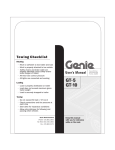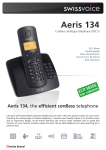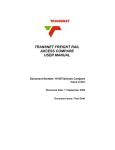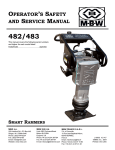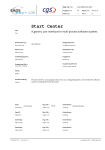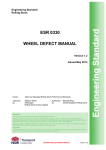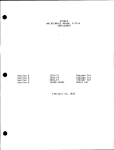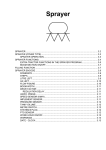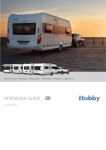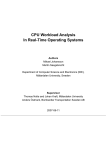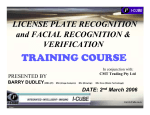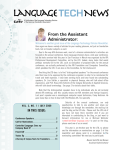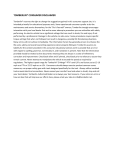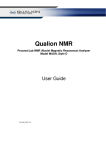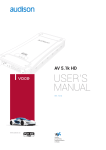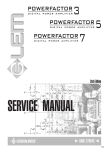Download RT_TE_PRO_0269_Numbering System Issue 1
Transcript
TRANSNET NUMBERING SYSTEM FOR INTERACTIVE ELECTRONIC MANUALS Document Number: RT/TE/SPC/0269 Document Reference: Transnet Numbering System Document Date: 30 June 2009 Document Issue: 1 Transnet Title Number Issue Date Prepared by RT/TE/SPC/0269 : Transnet Numbering System for IEMs : RT/TE/SPC/0269 : 1 : 30 June 2009 : Waymark Infotech (Pty) Limited Tom Higgins Waymark Approved by Date : Date Transnet Waymark Infotech (Pty) Limited P O Box 75434 Lynnwood Ridge 0040 Tel: (012) 369 0000 Fax: (012) 369 0500 Copyright © of this work is reserved under the Copyright Act of the Republic of South Africa (No 98 of 1978) and the provisions of the Berne Convention. This work or any part thereof may not be reproduced in any form or by any means without prior permission in writing of Transnet Limited unless in pursuance of the recommendations contained herein 30 June 2009 Issue: 1 Page i Transnet RT/TE/SPC/0269 TABLE OF CONTENTS 1. INTRODUCTION 3 2. PURPOSE 3 2.1 SCOPE 3 3. REFERENCED DOCUMENTS 4 4. ABBREVIATIONS AND ACRONYMS 4 5. SPOORNET NUMBERING STRUCTURE 4 5.1 LOCO CLASS CODE (XXXXXXXXXX) 6 5.2 SERIES (NNNN) 6 5.3 THREE ELEMENT CODE (NN-NNN-XXXXXXXX) 6 5.3.1 First Element (Chapter Number) (NN) 6 5.3.2 Second Element (Section/Sub Section) (NNN) 7 5.3.3 Third Element (Equipment) (XXXXXXXX) 13 5.3.4 Mod Status (XX) 13 5.3.5 Equipment Variant (A) 13 5.3.6 Information Code (NNN) 13 5.3.7 Information Code Variant (A) 13 5.3.8 Item Location (A) 13 5.4 DOCUMENT REVISION RECORDING 13 30 June 2009 Issue: 1 Page ii Transnet 1. RT/TE/SPC/0269 INTRODUCTION The introduction of the updated Class 9E, 11E and 18E locomotives and the purchase of the new 15E and 19E locomotives introduced equipment, particularly in the electronic control systems, that had not been used on SA locomotives before. In addition, Transnet decided to use electronic viewers in order for engineers and technicians to ‘view’ the technical support documents for these new and updated locomotives over Transnet’s Wide Area Network (WAN). This new method of viewing technical manuals ‘electronically’ required that each ‘bit’ of data be reduced to a relatively small ‘data module’ and allocated a unique identity. Technical documents produced as data modules and viewed electronically over a network are referred to as Interactive Electronic Manuals (IEM). This series of events caused Transnet to review the numbering system used for the development of technical documents that has been in use over many years. The company Waymark Infotech Pty Ltd was selected to work with Transnet's technical personnel to develop a numbering system that satisfies the requirements of the new environment. In addition to the points already listed, the basic requirements for the new numbering system were: 2. a. The numbering system in use throughout various Transnet affiliations should be retained as far as possible. b. The new system should make provision for the technical data sets for future locomotive purchases. c. Uniformity between the different classes of locomotive must be obtained. For example, the Main Compressor on the Class 18E should have the same basic identity as the Main Compressor on the Class 19E, even though they have different specifications and are manufactured by different suppliers. d. Should the need arise, it should be possible to adapt the numbering system to satisfy the requirements of other types of locomotive such as diesel electric locomotives. PURPOSE This document provides Transnet with a formal numbering system, as well as the approved data module breakdown, for use in the development of technical data for all electric locomotives that will use IEMs. Transnet have selected the aXcess EDMan data module management software as their software tool for developing IEMs. The business rules built into the EDMan software will automate a large percentage of the effort involved in allocating a Data Module Code (DMC). 2.1 SCOPE This document provides a breakdown of the numbering system to the detail of a DMC. It also includes a breakdown of the 3-element code that is used as the ‘heart’ of a DMC and includes the numbers currently used for the 9E, 18E and 19E equipment. The nature of changes within locomotives and their equipment will 30 June 2009 Issue: 1 Page 3 Transnet RT/TE/SPC/0269 undoubtedly result in DMCs being required that are not catered for in this document. When such a situation arises, the specific documentation contractor should contact Transnet's Project Manager for advice on how to number such modules. 3. REFERENCED DOCUMENTS The following documents are also applicable to the contents of this document: 4. a. Transnet’s User Guide for Technical Authors, document number RT/TE/PRO/0217, dated 30 June 2009. b. Transnet’s Document Type Definition Manual, document number RT/TE/PRO/0218, dated 30 June 2009. c. Transnet’s aXcess Electronic Documentation Manager (EDMan) User Manual, document number RT/TE/PRO/0214, dated 30 June 2009. d. Specification for Manual and Catalogues for Traction Vehicles, document number CSS.213/6.05, dated August 1985. e. AECMA S1000D, International Specification for Technical Publications Utilising a Common Source Data Base has been used as an aid in compiling this document. ABBREVIATIONS AND ACRONYMS The following abbreviations and acronyms are used in this document. Term 5. Meaning COE Centre of Excellence (maintenance facility) DMC Data Module Code IEM Interactive Electronic Manual Transnet All Transnet affiliations involved with IEMs WAN Wide Area Network SPOORNET NUMBERING STRUCTURE Figure 5.1: shows the numbering structure for a data module to be developed for a Transnet Electric Locomotive and for viewing as an IEM. The sub-paragraphs of this paragraph elaborate on the details of the elements of this numbering structure. 30 June 2009 Issue: 1 Page 4 Transnet RT/TE/SPC/0269 Figure 5.1: Numbering Structure Three Element Code CODE STRUCTURE XXXXXXXXXX - NNNN - NN - NN N - XXXXXXXX - XX A - NNN A - A Loco Class code Series Chapter Number Section Sub-Section Equipment Mod Status Equipment Variant Information Code Information Code Variant Item Location Where: X = Alphanumeric character N = Numeric character A = Alpha character The following is an example of a DMC applicable to a data module for a maintenance task for a component on a Class 18E locomotive. 18E-0000-12-011-01-00A-950A-A 18E - Loco Class Code Implies the 18E electric locomotive. Refer to paragraph 5.1 below 0000 - Series Implies the baseline model. Refer to paragraph 5.2 below 12 - Chapter Implies Chapter 12. Refer to paragraph 5.3.1 below 011 – Section/Subsection Implies section 01 and sub-section 1. Refer to paragraph 5.3.2 below 01 - Equipment Implies the first equipment within this sub-section. Please note that this allocation is project specific. 00A - Mod Status (Equipment) and Equipment Variant The 00 implies that this is original equipment and the A the first of 26 variants. Refer to paragraphs 5.3.4 and 5.3.5 below. 950A - Information Code and Information Code Variant The 950 implies general maintenance procedures, eg remove and install, and the A implies that it is the standard procedure. Refer to paragraphs 5.3.6 and 5.3.7 below. A - Item location Implies that the procedure will be performed on the locomotive. Refer to paragraph 5.3.8 below DMC 18E-0000-12-011-01-00A-950A-A refers to an 18E Electric locomotive, baseline model (0000), chapter 12, data module section 01 and sub-section 1 with information relevant to the first component (01) for 30 June 2009 Issue: 1 Page 5 Transnet RT/TE/SPC/0269 the driver's cab ventilator. The modification status and equipment variant (00A) indicates that this is still the original component. The information code and information code variant (950A) indicate it is the standard maintenance procedure and will be performed on the locomotive. Notes to the above example: Only three characters are used for the Loco Class Code in this example but please note that up to 10 characters can be used in order to allow for variants to the same basic locomotive class. Only two characters were used for the Equipment Code in this example, but please note that up to eight characters can be used. Usually only two are used in the case of mechanical components but up to eight might be used in the case of electric components e.g. U1_RY1 will be for Relay No. 1 in Inverter Unit (U1). 5.1 LOCO CLASS CODE (XXXXXXXXXX) This element identifies the applicable class for the documentation. It refers to the highest level classification of an asset and will normally be the complete electric locomotive. Examples of codes identified for this number element are 18E, 9E, 11E, etc. 5.2 SERIES (NNNN) This element identifies the applicability of the data module on possible locomotive series. This refers to the highest level classification of an asset variant, such as the electric locomotive. Examples of codes identified for this number element are 0000 which implies the locomotive baseline, 0015 implies applicability to series 1 through 4 etc. This is input into the data module as a binary number to cater for the variety of series’ that might be applicable to a locomotive class. 5.3 THREE ELEMENT CODE (NN-NNN-XXXXXXXX) The definitions and allocations for the Three Element Code are defined in the following paragraphs and, as far as possible, comply with the numbering system used for older locomotive types that do not have electronic documentation. The major change to the previous 3-element number is in the allocation of numbers to electrical chapters 20 to 28. 5.3.1 First Element (Chapter Number) (NN) Codes identified for this number element are shown in Table 5.1 below. Table 5.1: First Element (Chapter) Code Definition of Three Element Code First Element Chapter Description 01 Vehicle Complete 02 Extract from Driver’s Manual 30 June 2009 Issue: 1 Page 6 Transnet RT/TE/SPC/0269 First Element Chapter Description 03 General Mechanical Requirements and Procedures 05 Bogie 10 Body and Under-frame 12 Ventilation and Filtration Systems 15 Compressed Air and Vacuum Supply Systems 16 Compressed Air Operated Ancillary Equipment 17 Brake Systems 20 General Electrical Requirements and Procedures 21 Main Power Traction System 22 Auxiliary Systems 23 Driver Ancillary Electrical Systems 24 Locomotive Control 25 Communication Systems 26 Electronic Control Systems 27 Measurement and Detection Systems 28 Indication Systems 5.3.2 Second Element (Section/Sub Section) (NNN) The Second Element codes, associated with the First Element Codes from 5.3.1 above, are presented in Table 5.2 below for chapters covering mechanical systems. Table 5.2: Second Element (Section/Sub-section) Code Definition of Three Element Code Second Element Chapter Section 01 Contents Vehicle Complete 000 30 June 2009 Title General This section provides a basic introduction to the locomotive and its functions as a whole with cross-references where applicable. It also includes information for power circuits, motoring, frame, underframe and bogies. Issue: 1 Page 7 Transnet RT/TE/SPC/0269 Second Element Chapter Section 30 June 2009 Title Contents 010 Technical data This section includes terms and their meanings as applied to this documentation. It also includes the outline and technical data relevant to the locomotive such as traction and braking curves 020 Principal Dimensions This section provides all principal dimensions applicable to the locomotive. Should contain a least a side and end elevation figure with primary dimensions indicated. 030 Equipment Layout This section includes the general layout of all major equipment in the vehicle body and the cab(s) equipment layouts. An end view of the locomotive showing the piping and coupling arrangement should be included. 040 Operating Instructions This section includes the procedures for starting-up in each different mode, external examination, internal examination and the stabling (shutting down) of the locomotive. 050 Scheduled Maintenance This section includes all scheduled maintenance by frequency for all relevant equipment. These should also show 'shedding' periods and the tasks applicable to each shedding. 060 Lifting And Jacking This section provides information for, lifting the complete locomotive with bogies, lifting the body and replacing body/bolsters onto bogies. 070 Mass And Axle Mass Loads This section includes information relevant to the mass and axle/mass loads. 080 Painting Provides information relevant to the paint procedures of the locomotive, including a painting Issue: 1 Page 8 Transnet RT/TE/SPC/0269 Second Element Chapter Section Title Contents diagram and location of logos. 090 02 03 30 June 2009 This section provides information on safety factors that might influence personnel. This will include the fire extinguisher, warning signs, use of warnings and cautions in modules, etc. Driver’s Manual 010 Preparation for operation 020 Operating Procedures This section provides information on procedures that are applicable to technical personnel who are required to motor (drive and brake) and/or shut down the locomotive. This section provides information on procedures that are applicable to technical personnel who are required to prepare a locomotive for motoring. General Mechanical Requirements and Procedures 010 Mechanical Requirements This section includes general mechanical requirements such as torques, lifting of heavy equipment, etc. It will also contain any specific Transnet regulations applicable to mechanical systems in general. 020 Mechanical Procedures This section includes general procedures for welding, brazing etc. 05 05 Safety Factors Bogie 000 General This section includes an illustration and functional description of the complete bogie. 010 Frame This section includes information relevant to the frame assemblies, piping and the sanding system. Issue: 1 Page 9 Transnet RT/TE/SPC/0269 Second Element Chapter Section 05 05 30 June 2009 Title Contents 011 Frame Assemblies 012 Piping 013 Sanding System Covers the mechanical components of the sanding system that are fitted to the bogies, usually from the activating valve to the nozzles. 020 Brake Rigging This section includes information relevant to the brake blocks, brake rigging, brake blocks and shoes, these being components of the brake systems that are fitted to the bogie. 021 Brake Blocks 022 Inner Rigging 023 Outer Rigging 024 Centre Rigging 025 Handbrake Assembly Components of the handbrake assembly that are fitted to the bogie. 030 Spring Rigging This section provides information relevant to mechanical, hydraulic and pneumatic spring rigging. It covers bolsters, spring planks, equalizing beams, bolster anchors, vibration damping devices and friction snubbers. 031 Mechanical 032 Hydraulic 033 Pneumatic 040 Wheel sets 041 Fixed Wheelset Assembly This section provides information relevant to fixed wheelset assemblies, self steering wheelset assemblies and wheelset measurement systems. It includes wheels, axles, axleboxes, attachment covers, gearwheels, gearcases and odemeters. Issue: 1 Page 10 Transnet RT/TE/SPC/0269 Second Element Chapter Section 05 05 30 June 2009 Contents 042 Self Steering Wheelset Assembly 043 Measurement 050 Inter-bogie Control 051 Spring Boxes 052 Frame Assemblies 053 Safety Links 054 Safety Clamps 060 Weight Transfer Equipment 061 Mechanical Weight Transfer Equipment Assembly 062 Pneumatic Weight Transfer Equipment Assembly 070 Unassigned 080 Motor Suspension 10 10 Title This section provides information relevant to spring boxes, springbox to bogie assemblies, safety cables and suspension equipment. This section includes information relevant to mechanical weight transfer equipment and pneumatic weight transfer equipment. This section includes all information relevant to the traction motor suspension systems and equipment fitted to the bogie. Body and Under-frame 000 General This section includes information relevant to the body layout, underframe layout and procedures for structural repairs. 001 Body Layout Sides A and B and No 1 and No 2 End 002 Underframe layout Location of all equipment attached to the underframe 003 Structure Repair Specific procedures for repairs to the loco structure Issue: 1 Page 11 Transnet RT/TE/SPC/0269 Second Element Chapter Section 10 10 30 June 2009 Title Contents 010 Body Structure This section includes information relevant to driver’s cab arrangement, exterior cab fittings, roof layout, flooring, piping, conduit, ducting, cleating arrangements, body mounted equipment, non-driver’s cab arrangement and cladding arrangement. 011 Driver’s cab arrangement Desks and seats, arm rests, sun visor arrangements, small fittings and horn lanyards in the driver’s cab. 012 Exterior cab fittings Steps and handrails, mirrors, wipers 013 Roof layout No 1 end, No 2 end and centre roof(s) 014 Flooring Cabs, corridor and compartment flooring 015 Body ducting Drains, piping, gutters, piping and ducting 016 Body mounted equipment installation 017 Non-driver’s cab arrangement 018 Cladding arrangement 020 Doors And Windows This section includes information relevant to doors, removable covers, panels, interlocking, fixed windows and drop-down & sliding windows. 021 Doors Side and end doors, compartment doors and maintenance doors 022 Covers Cab’s covers and machine compartment covers 023 Panels All control panels with legends 024 Interlocking Complete interlocking procedure 025 Not assigned Issue: 1 Page 12 Transnet RT/TE/SPC/0269 Second Element Chapter Section 10 10 10 30 June 2009 Title Contents 026 Not assigned 027 Not assigned 028 Fixed windows 029 Drop down and sliding windows 030 Under-frame Structure 030-01 Drag Box 031 Underframe mounted equipment 031-01 Cow catcher 031-02 Sanding system 031-03 Battery box arrangement 032 Piping, conduit and ducting 040 Couplers And Drawgear This section includes information relevant to the coupler and drawgear arrangement and the coupler release system. 041 Couplers and draw gear arrangement At both ends 042 Coupler release system 050 Equipment Frames and Equipment Cubicles This section includes information relevant to all equipment frames and equipment cubicles. Does not include the electrical equipment contained inside. 051 Frames HT, LT and air equipment frames. Desk frames, aircon mounting frame, water tank frame and air duct support frames. 052 Cubicles The location of all equipment frames is to be illustrated with references out to the specific This section includes information relevant to the drag box, underframe mounted equipment installations and underframe piping, conduit and ducting. Issue: 1 Cow catcher, snad box and battery box arrangement Page 13 Transnet RT/TE/SPC/0269 Second Element Chapter Section Title Contents equipment, examples of cubicles are HSCB, toilet, and power conversion equipment cubicles. 10 10 12 060 Insulation, lining and trimming 061 Insulation 062 Lining and trimming 070 Sanitary System 071 Toilet system 072 Basin system 073 Water supply system 074 Drain system This section includes information relevant to the insulation, lining and trimming used on the locomotive. This section includes information relevant to the sanitary system, including toilet, water storage, waste disposal, basin and piping. Refer out to applicable chapters for toilet ventilation and lights. Ventilation and Filtration Systems 12 000 General This section provides a breakdown of different ventilation systems, cooling systems, heating and filtration systems provided for the locomotive. Electronic control for such systems is covered in chapters 23 and/or 24. 12 010 Compartment Ventilation Provides information relevant to introducing ambient conditions into a compartment or cubicle and includes systems such as ventilator arrangements, monsoon arrangements and electronic cubicle ventilation. 011 Driver’s cab ventilation 012 Machine compartment ventilation 30 June 2009 Issue: 1 Page 14 Transnet RT/TE/SPC/0269 Second Element Chapter Section 12 12 12 30 June 2009 Title Contents 013 Non-driver’s cab ventilation 020 Equipment Ventilation This section includes information relevant to ventilation systems responsible for providing ventilation to specific equipment and/or the direct environment thereof. 021 Traction motor ventilation system 022 Resistor enclosure ventilation 023 Driver’s desk ventilation system 024 Filter Reactor ventilation system 025 Power Conversion cubicles ventilation system 026 Battery box ventilation 027 Communications Cubicle ventilation 030 Domestic Cooling Systems 031 Air-conditioning System 032 Ancillary Cooling Systems Used on Class 9E and 11E. 040 Equipment Cooling systems This section provides information relevant to equipment that provides cooling for non-domestic systems and components. 041 Main Transformer cooling system This section provides information on the components used to cool the main transformer Issue: 1 On Class 11E and 9E all TM blower ventilation is covered under 12-020. On Class 11E and 9E the Desk Fan is covered under 12-020-07. This section includes information relevant to all domestic cooling systems. Electronic control for such systems is covered in Chapters 23 and/or 24. Page 15 Transnet RT/TE/SPC/0269 Second Element Chapter Section Title Contents 042 PCC cooling system This section provides information on the components used to cool the Power Converter Cooling system such as the PCC on the 19E or the Converter Cooling equipment on the 11E. 043 Cooling Tower Ventilation Describes cooling ventilation equipment that is applicable to more than one item of equipment, for example on the 19E the Cooling Towers provide ventilation to the PCC and the TM blowers. 050 Domestic Heating Systems This section includes information relevant to all domestic heating systems. Electronic control for such systems is covered in Chapters 23 and/or 24. 051 Foot Heating System On Class 11E and 9E this is called Cab Heating System. 12 060 Equipment Heating Systems This section includes information relevant to all arrangements associated with introducing heated conditions (forced or natural ventilation) to specific equipment or systems. Electronic control for such systems is covered in Chapters 23 and/or 24. 12 070 Filtration This section includes information relevant to the different filtration components. 071 Ventilation Filters 072 Compressed Air Filters 073 Vacuum Filters 074 Oil filters 12 15 30 June 2009 Compressed Air and Vacuum Supply Systems Issue: 1 Page 16 Transnet RT/TE/SPC/0269 Second Element Chapter Section Title Contents 15 000 General This section provides a breakdown of the air, vacuum and auxiliary supply systems including a functional description of such systems. Electronic control for such systems is covered in Chapters 22 and/or 24. 15 010 Compressed Air Supply Systems This section includes information relevant to the compressed air supply system including valves, cocks, filters, pressure governors, regulators, switches, piping, drains and reservoirs. On Class 11E and 9E the Compressor is covered under 15-010-01. 011 Compressed Air Supply 012 Valves 013 Cocks 014 Filters 015 Pressure Governors, Regulators and Switches 016 Couplings and Piping Arrangement 017 Drains 018 Reservoirs 019 Miscellaneous 020 Vacuum Supply System 021 Vacuum Supply 022 Valves 023 Cocks 024 Filters 025 Vacuum Governors, 15 30 June 2009 This section includes information relevant to the vacuum supply system including valves, cocks, filters, pressure governors, regulators, switches, piping, drains and reservoirs. Issue: 1 Page 17 Transnet RT/TE/SPC/0269 Second Element Chapter Section Title Contents Regulators and Switches 15 15 30 June 2009 026 Piping Arrangement 027 Drains 028 Reservoirs 029 Miscellaneous 030 Aux Compressed Air Supply Systems 031 Auxiliary Compressed Air Supply 032 Valves 033 Cocks 034 Filters 035 Pressure Governors, Regulators and Switches 036 Piping Arrangement 037 Drains 038 Reservoirs 039 Miscellaneous 040 Reduced Auxiliary Compressed Air Supply 041 Valves 042 Cocks 043 Filters 044 Measurement and Gauges 045 Pressure Governors, Regulators and Switches Issue: 1 This section includes information relevant to auxiliary compressed air supply system including minicompressors, valves, cocks, filters, pressure governors, regulators, switches, piping, drains and reservoirs. On Class 11E and 9E the Aux Compressor is covered under 15-030-01 Page 18 Transnet RT/TE/SPC/0269 Second Element Chapter Section 16 16 16 30 June 2009 Title Contents 046 Piping Arrangement 047 Drains 048 Reservoirs 049 Miscellaneous Ancillary Mechanical Systems 000 General This section provides a breakdown of all the ancillary equipment driven by compressed air. This section includes the pantograph, horn, pneumatic windscreen wiper and sanding system. 010 Pantograph Systems This section includes information relevant Electronic control for such systems is covered in chapters 22 and/or 24.to compressed air operated equipment including valves, cocks, filters, measurement and gauges, pressure governors, regulators, switches, piping, drains and reservoirs associated with the pantograph systems. Electronic control for such systems is covered in Chapter 24. 011 Valves 012 Cocks 013 Filters 014 Measurement and Gauges 015 Pressure Governors 016 Piping Arrangement 017 Drains 018 Reservoirs 019 Miscellaneous 020 Horn System Description of the air operated horn system and associated components. Electronic control for such systems is covered in Issue: 1 Page 19 Transnet RT/TE/SPC/0269 Second Element Chapter Section Title Contents Chapter 24. 16 16 30 June 2009 021 Valves 022 Cocks 023 Filters 024 Measurement and Gauges 025 Pressure Governors 026 Piping Arrangement 027 Drains 028 Reservoirs 029 Miscellaneous 030 Sanding System 031 Valves 032 Cocks 033 Filters 034 Measurement and Gauges 035 Pressure Governors 036 Piping Arrangement 037 Drains 038 Reservoirs 039 Miscellaneous 040 Windscreen Wiper System Issue: 1 The Horn Piping Assembly is covered in this section on the Class 11E and 9E. Description of the air operated components of the sanding system and associated components. Electronic control for such systems is covered in Chapter 24. Description of the air operated components of the windscreen wiper system and associated components. Electronic control for such systems is covered in chapters 24. On Class 11E and 9E the Sanding system is covered in this section. Page 20 Transnet RT/TE/SPC/0269 Second Element Chapter Section 16 16 Title Contents 050 Sanitary System 051 Valves 052 Cocks 053 Filters 054 Measurement and Gauges 055 Pressure Governors 056 Piping Arrangement 057 Drains 058 Reservoirs 059 Miscellaneous 060 HT Equipment Air Supply Description of the air operated components of the sanitary system and associated components. Description of the provision of air to specific HT equipment. 061 062 063 17 17 30 June 2009 Filters Brake Systems 000 General This section provides a breakdown of the braking systems on the locomotive. Electronic control for such systems is covered in Chapter 24. 010 Automatic Train / Loco Proportional Brake System This section includes information relevant to the functional operation of the gradual release, direct release vacuum, electrovacuum and electro-pneumatic control of the train/loco brakes. On Class 11E and 9E the CCBII system is covered in this section. 011 Valves 012 Cocks 013 Filters Issue: 1 Page 21 Transnet RT/TE/SPC/0269 Second Element Chapter Section 014 Title Contents Measurement and Gauges 015 016 Couplings and Piping Arrangement 017 Reservoirs 018 17 17 30 June 2009 019 Miscellaneous 020 Straight Air Brake System 021 Valves 022 Cocks 023 Not yet assigned 024 Not yet assigned 025 Not yet assigned 026 Couplings and Piping Arrangement 027 Reservoirs 028 Not yet assigned 029 Miscellaneous 030 Computer Controlled Braking II This section includes information relevant to the mechanical components of the CCBII system. Details of the electronic equipment are covered in Chapter 26. 031 Electro-Pneumatic Control Unit This section includes information relevant to the EPCU 032 Electronically Controlled Pneumatic Brake System This section includes information relevant to the equipment used in the ECP Braking System 033 Wire Distributed Power This section includes information relevant to the mechanical components of the WDP system. The electronic components are Issue: 1 This section includes information relevant to the operation of the locomotive independent brake system and/or train holding system. Page 22 Transnet RT/TE/SPC/0269 Second Element Chapter Section Title Contents discussed in Chapter 26-070 Trainline Control. 17 040 Not Used Left open for possible future use. 17 050 Electric Dynamic Brake This section includes information relevant to the mechanical/pneumatic components of the electric brake systems including regenerative and rheostatic braking systems. Include references to 21-050 and 24-030 for electrical interfaces. 051 Regenerative Braking System Discuss mechanical and pneumatic components and refer to 21-050 and 24-030 for electrical components and controls. 052 Rheostatic Braking System Discuss mechanical and pneumatic components and refer to 21-050 and 24-030 for electrical components and controls. 060 Safety Vigilance System This section includes information relevant to the air operated components responsible for the operation of the vigilance system. Refer to 24-060 for electronic control of the system. 061 Valves 070 Stationary Braking System 071 Hand/Parking Brake 072 Dual Pressure/ Holding Brake System 080 Piping Diagrams 17 17 This section includes information on the stationary braking system including the hand/parking brake and the dual pressure/holding brake system. On Class 11E and 9E piping diagrams are covered in this section. The Second Element codes, associated with the First Element Codes of 5.3.1 above are presented in Table 5.3 below for chapters covering 30 June 2009 Issue: 1 Page 23 Transnet RT/TE/SPC/0269 electrical systems. Table 5.3: Second Element (Section/Sub-section) Code Definition of Three Element Code Second Element Chapter Section 20 20 20 30 June 2009 Title Contents General Requirements for All Electrical Systems 000 General Electrical standards, HT requirements, cable and insulation 001 General electrical practices Information relevant to electrical practices on the locomotive. 002 High voltage requirements 003 Generic Electrical Component Specifications 004 Equipment Earthing Procedures 010 Electrical wiring components 011 Cable and insulation specifications 012 Connection plugs & sockets 013 Connectors general 014 Not currently used 015 Optical Fibres General details and specifications of optical fibres used on the locomotive. 020 Wiring and assembly diagrams Wiring, circuit and electrical assembly diagrams are normally viewed via the SPC viewer and reference should be made to the applicable collections. On some classes of locomotive the circuit diagrams are covered in this section. Issue: 1 Information on how individual electrical cabinets and frames are earthed to the locomotive Page 24 Transnet RT/TE/SPC/0269 Second Element Chapter Section 21 21 30 June 2009 Title Contents 021 Electrical frame assemblies Describes the components in each frame and references out for operational data on individual components. 022 Electrical cubicle / compartment arrangements Describes the components in each cubicle and references out for operational data. 023 Electrical rack assemblies Describes the components in each rack and references out for operational data. 024 Electrical control panel assemblies Describes the components in each control panel and references out for operational data. 025 Electrical Circuit Description Only used on Class 11E and 9E. Brief description of main and auxiliary power circuits Main Power Traction System 000 General 010 Main Electrical Power Supply System Covers all components that supply HT power to the locomotive. 011 Roof equipment Describe function & purpose of items in system. Pantograph control will follow in 24-011. Top illustration of roof, brief description of each item 012 Supply protection systems Components that protect the main supply such as HSCB, CBR, VCB 013 Supply Switchgear Details on switchgear in the circuit of the main power supply such as AC/DC charging contactors, panto isolators, AC/DC changeover switches, etc. 014 Supply filtering Describes equipment that provides filtering of the main input supply 015 Main transformer system Provides a description of the main transformer and associated Issue: 1 Page 25 Transnet RT/TE/SPC/0269 Second Element Chapter Section Title Contents equipment with references out to equipment cooling, etc 016 Power Factor Correction Systems 017 Not yet assigned 018 Not yet assigned 019 Miscellaneous 21 020 AC Supply Power Converter 21 030 DC Supply Power Converter 21 040 Propulsion systems Includes all HT components/systems used to switch/regulate the main power according to the traction demand. 041 Traction motors Describes the operation of the traction motor system and the individual components. 042 Propulsion Switchgear Describes the supply to the traction motors via components such as gate amplifiers, IGBTs, inverter, electro-pneumatic contactors and converter units. Covers Four Quadrant Controllers on 19E. 043 Main resistors Also covers Armature Converter on Class 9E and 11E. 044 Weakfield system Includes Field converter on Class 9E and 11E. 050 Electric Braking System Includes all components/systems used to switch/regulate the electric braking systems. Refer to Chap 17 for mechanical and pneumatic components. 051 Rheostatic braking system Refer to Chap 17 for applicable mechanical and pneumatic components. Describe electrical components involved in 21 30 June 2009 Earth return bushgear, AC down lead and other equipment not falling under any of the above descriptions Issue: 1 Page 26 Transnet RT/TE/SPC/0269 Second Element Chapter Section Title Contents rheostatic braking operations with refs to chap 26 for control 21 21 052 Regenerative braking system 060 Electrical interlocking and isolation 061 HT isolating system 062 HT interlocking system 090 Earthing and Isolating Equipment 22 30 June 2009 Refer to Chap 17 for applicable mechanical and pneumatic components. Describe electrical components involved in regen braking operations with refs to chap 26 for control Includes systems such as the Earth Return Brushes, Isolating Switches, etc. Secondary/auxiliary electrical systems/equipment that do not form part of the propulsion/braking circuit and without which the locomotive is unable to function properly. Auxiliary Systems 000 General 010 Auxiliary Power Supply Systems Systems responsible for the electrical supply used by the auxiliary, driver ancillary, locomotive control, electronic control power supply and all other secondary systems. Examples include Motor Alternator circuit, Motor Exciter circuit, Static Inverters, etc. 011 Motor alternator system Covers primary aux power supply system on 9E and 11E. 012 Motor exciter system Covers battery power and control system on 9E and 11E. 013 Battery, shore and emergency supply Describe each individual subsystem and the respective components. Include circuit diagrams to aid in understanding. Covers 12 and 24V supplies on 9E and 11E. Issue: 1 Page 27 Transnet RT/TE/SPC/0269 Second Element Chapter Section 22 22 22 22 30 June 2009 Title Contents 014 Auxiliary and control positive supply Describe all components that provide auxiliary electrical supplies to the loco, include circuit diagrams to help understanding. Also covers aux transformer on 9E and 11E. 015 Steam tender supply 016 Power Supply Units 020 Compressed air supply systems 021 Main compressor system 022 Auxiliary compressor system 030 Vacuum supply systems 031 Exhauster system 040 Equipment cooling systems Describe how cooling is provided to electrical equipment and cubicles. 041 Main Transformer cooling system Describe how the main transformer is kept cool during operation. 042 Power Conversion Component Cooling System Describe how the components inside the PCC are kept cool during operation. Referred to as Converter Cooling System on 9E and 11E. 050 Forced ventilation systems 051 Brake Resistor enclosure ventilation system 052 Driver’s desk ventilation system 053 Traction Motor Ventilation System Covers Aux blower on 9E and 11E. 054 Converter blower On 9E and 11E Describe individual PSUs that are not specific to a separate system or sub-system. . Issue: 1 Page 28 Transnet RT/TE/SPC/0269 Second Element Chapter Section Title Contents 055 Brake resistor blower On 9E and 11E 056 TM blower On 9E and 11E 057 Radiator (oil cooler) blower system On 9E and 11E 22 060 Equipment heating systems Description of systems that provide heating to specific electronic/electric equipment 22 070 Compartment pressurization systems Methods and associated equipment for providing pressurization inside compartments or cubicles. 23 23 23 23 30 June 2009 Driver Ancillary Electrical Systems This section includes the first level system breakdown description of all the Driver Ancillary Electrical Systems, including a block diagram that illustrates the interaction of the various sub-systems with interactive links to their respective system descriptions. 000 General 010 Domestic cooling systems General description, with references to all domestic cooling systems on the loco. 011 Air conditioner system Describe the purpose of the air conditioner system and of the items. System circuit diagram. System interaction at start up. Ref to frame assembly in Chap 20 and to Chap 12 for mechanical components. 012 Fridge System Show location and circuit description for fridge. 020 Domestic ventilation systems General description, with references to all domestic ventilation systems on the loco. 021 Toilet ventilation circuit Describe the purpose of the toilet ventilation system and of the items. System circuit diagram. 030 Domestic heating General description, with Issue: 1 Page 29 Transnet RT/TE/SPC/0269 Second Element Chapter Section Title Contents systems references to all domestic heating systems on the loco. 031 Hot plate circuit Describe the purpose of the hot plate circuit and of the items. System circuit diagram and locations. 032 Foot heater circuit Describe the purpose of the foot heater circuits and of the items. System circuit diagram and locations. 033 Warming Drawer circuit. Describe the purpose of the microwave circuit and of the items. System circuit diagram and locations. 23 040 Doors ancillary electrical systems This section includes all electrical equipment and the control thereof associated with doors e.g. Electronically Controllable Doors, etc 23 050 Windows ancillary electrical systems This section includes all electrical equipment and the control thereof associated with windows. 051 Electrical windshield wiper system Describe the purpose of the windscreen wiper system and of the items. System circuit diagram. 23 060 Domestic electrical sockets Describe domestic electrical sockets, their supply and location. 23 070 Lighting Purpose of lighting. List subsubsystems -71 to -73. Lighting supply and protector and timer circuit diagram How lighting system in general operates e.g. delays, voltage limits. Describe emergency lighting and see-mehome lighting systems where applicable. 071 Cab Lighting Describe the purpose of cab lighting and of the items. System circuit diagram 072 Corridor and Compartment Lighting Describe the purpose of corridor and compartment lights and of the items. System circuit diagram. 30 June 2009 Issue: 1 Page 30 Transnet RT/TE/SPC/0269 Second Element Chapter Section 30 June 2009 Contents 073 Exterior Lighting Describe the purpose of exterior lights and of the items. System circuit diagram 074 Instrument and Gauge Lighting Describe specific additional lighting that illuminates instruments and/or gauges. 24 24 Title Locomotive Control 000 General This chapter contains all the electrical control systems, diagrams and circuits associated with the main electrical power system and locomotive motion control systems 010 Main Electrical Power Supply Control System This section includes information relevant to the control of the main electrical power supply. This section includes the pantograph control system and the primary circuit breaker control system. 011 Pantograph Control Describe the purpose of pantograph control and of the items. System circuit diagram. Mention auxiliary compressor and main air systems support and status indication Ref chap 16 & 21 use in conjunction with chap 16 (flow diagram, "fill in" electric blocks) 012 HSCB control Describe the purpose of HSCB control and of the items. Mention HSCB control instances (e.g. by Agate) and status indication ref HSCB itself. Link to chap 21 Normal open & close as well as trip conditions 013 Emergency System Describe the purpose of emergency system and of the pushbutton. Describe operation using the circuit diagram. Consist and alone conditions and leading/trailing. 014 Current Balance Describe what happens when Issue: 1 Page 31 Transnet RT/TE/SPC/0269 Second Element Chapter Section Title Contents Protection System 24 30 June 2009 CBR trips. Describe operation using the circuit diagram 015 PFC Control 016 VCB Control Describe the operation of the VCB control circuit using applicable diagram. Covered under 24-012 on 9E and 11E. 017 AC/DC Change over control Describe the operation of the AC/DC control circuit using applicable diagram. 020 Propulsion Control System Describe the purpose of the propulsion control system. State modes of operation. Methodology of control. Driver interface description. Refer to startup control procedure (chap 1 currently) Referring back to 2140, describe system level operation. List sub-subsections 021 Stand-Alone, Lead & Trail Control Describe the stand-alone, lead & trail control concept. What happens on LT circuit, how is loco configured (contactor wise for leading or trailing) 022 Forward & Reverse Control This section includes all the control circuits/equipment responsible for Forward and Reverse Operation. This General portion of this section includes the sequence chart, traction effort curves and simplified diagrams of the main power circuit during Forward and Reverse Operation 023 Series, Parallel and Transition Control Describe the way series, parallel & transition control is achieved referring to 24-20 and 21-40 and S59.Describe configurations for series, parallel & transit. For 18E use same transition figs as in 6E1 024 Motoring Notching Control Describe the way motoring notching sequencing works referring to 24-20 and 21-40. Ref to tractive effort curves in chap 1. Issue: 1 Page 32 Transnet RT/TE/SPC/0269 Second Element Chapter Section Title Contents Referred to as Motor and Braking Control (Traction Control) on 9E and 11E. 24 24 30 June 2009 025 Weakfield Control This section includes all the control circuits/equipment responsible for Weakfield Operation. This General portion of this section includes the sequence chart, traction effort curves and simplified diagrams of the main power circuit during Weakfield Operation 026 Manual Cut-out This section includes all the control circuits/equipment responsible for Cut-Out Operation. The effect of cutting out equipment must be indicated as well as the process to do so. 027 Slow speed control The purpose and method of selecting slow and/or 2/3 rd speed must be explained. Reference must be made to the tractive effort for each mode. Covers Bogie/Motor Cut-out on 9E and 11E. 030 Electric Braking Control This section includes all the electrical circuits/equipment responsible for rheostatic/electrical braking operations. 031 Rheostatic Braking Control Definition of rheostatic braking must be supplied as well as effect of this operation. 032 Regenerative Braking Control Definition of regenerative braking must be supplied as well as effect of this operation. 040 Pneumatic Braking Control System Describe the way pneumatic braking control is achieved referring to the system items and 24-40.Ref to braking in chap 17 041 Pneumatic Braking control Describe the specific components involved in this operation. 042 Park brake Control Describe the specific components Issue: 1 Page 33 Transnet RT/TE/SPC/0269 Second Element Chapter Section Title Contents involved in this operation. 24 25 30 June 2009 050 Adhesion Optimisation This section contains all the electrical systems responsible for minimising the slipping/sliding of the wheels on the tracks. 051 Sanding Control System Operation of the sanding system referring to its elements, indications and the speed sensor/control system interface. Automatic & manual mode, refer buzzer, screen indications. 052 Wheelslip Control System Operation of the wheelslip control system referring to its elements, indications and the speed sensor/computer interface. 053 Wheel slide Control Operation of the wheel slide control system referring to its elements, indications and the speed sensor/computer interface. 054 Electric Weight Transfer 060 Vigilance System 070 Trainline Control System 071 Locomotive Trainline Control 080 External Control Signals 081 Track Magnet System Purpose of the vigilance system, operation, (times, setting up trip, reset) indications and the control system interface and listing of elements. Purpose of the trainline control system. Fwd, reverse, emergency, leading & trailing using a circuit diagram. Application of the trainline control system for locomotive control. Show wiring diagrams, socket locations Communication Systems Issue: 1 Page 34 Transnet RT/TE/SPC/0269 Second Element Chapter Section Title Contents 000 General Purpose of communication systems & listing of subsystems 10 and -30 010 Driver Communications System Purpose & operation of driver communication systems, listing sub-subsystems 011 Communications Radio System Operation and system description of radio communications. 012 Mobile Phone System Describe mobile phone installation. 013 Music & Entertainment Equipment Describe music & entertainment interfaces and components. 014 Train Cab System Description the operation of TCS including components, interfaces and locations. 25 020 Triton System Provides brief description of function and equipment of the Transnet Triton communications system. 25 030 Tracking & Navigation Systems Describe tracking & navigation systems 031 GPS Interface of GPS with other control systems. Describe equipment, locations, supplies, etc. 032 Onboard Computer System Describes the system and equipment used to aid the driver to navigate and track progress. 040 Telemeter Systems 25 25 26 26 30 June 2009 Electronic Control Systems 000 General This section contains all the pin definitions, circuits diagrams and software associated with Electronic Control equipment/systems. 010 AGATE System Description of AGATE system, listing sub-subsystems -11 through -15. Used for MITRAC system on 9E and 11E. Issue: 1 Page 35 Transnet RT/TE/SPC/0269 Second Element Chapter Section Title Contents 011 Power Supply Describe system power supplies 012 Controllers & Interface Definitions Describe controllers and connections. Complete interface (input and output) tables where applicable. List circuit cards and their locations in controller units, for example (MPU/RIOMs) 013 Display & Indication Describe operation of DDUs and how to access different screens. 014 Fault Codes Describe how to access fault codes and where they are displayed on the DDUs. 015 Communications Networks Describe interfaces. Local FIP and train FIP, RS 232 & 485, Data download, DDU programming, MPU connection plug 016 Data Loggers & Event Recorders 017 Programming & Diagnostic Utilities 26 020 Train Control & Monitoring System Description of TCMS, listing subsubsystems -021 through -026 as for above system. 26 030 Train Cab System Description of TCS, listing subsubsystems -031 through -036 as for above system. 26 040 Computer Controlled Braking (CCBII) Description of CCBII, listing subsubsystems -041 through -046 as for above system. 27 Measurement and Detection Systems 000 30 June 2009 General This chapter contains all the measurement and detection systems. The entire system must be described from the point of measurement /detection up to where the data is electronically converted and "handed" over for indication/display or control purposes Issue: 1 Page 36 Transnet RT/TE/SPC/0269 Second Element Chapter Section 27 Title Contents 010 Voltage, Current & Power General notes on voltage, current & power measurement, list items under -011 with locations and concise principle of operation for each type 011 Main Power Measurement System Used for voltage measurement equipment on 9E and 11E. 012 Aux Power Measurement System List all systems measuring auxiliary power. Used for current measurement equipment on 9E and 11E. 020 Speed, Frequency, Period General notes on speed, frequency & period measurement, tabulate location of listed items with concise principle of operation for each type 021 Axle Speed Measurement System Description of operation of axle speed measurement principle and details of equipment. 030 Pressure General notes on pressure measurement, tabulate location of listed items with concise principle of operation for each type 031 Air & Vacuum Measurement System 032 Air Pressure Detection Details of air pressure detection sensors and their locations. 27 040 Flow This includes the measurement of the flow rate of liquids/gasses or the flow limit detection thereof (HIGH/LOW) E.g. Diesel consumption measurement using a flow meter system, Low air flow detection, etc. 27 050 Liquid Levels This includes the measurement of various liquid levels or the level detection thereof (HIGH/LOW) eg. Diesel tank level measurement system, Low oil level detection, etc. 27 27 30 June 2009 Issue: 1 Page 37 Transnet RT/TE/SPC/0269 Second Element Chapter Section Title Contents 27 060 Digital Feedback Digital feedback indicating the status (open/close, on/off) of any switch, relay, contactor, control arm, etc. 27 070 Temperature Details and functions of equipments that measure temperature and provide signals to their control systems. 071 Air Temperature Details and functions of equipments that measure the temperature of the air in an area and signal their control systems. 072 Component Temperature Details and functions of equipments that measure the temperature of components and signal their control systems. 080 Fire Detection System Description of the operation of components that detect possible fire and provide signals to a control system. 27 28 Indication Systems 000 General This section provides a breakdown of the types and methods of indication systems. This section contains all the electrical/electronic Indication systems/panels. It also serves as a quick reference to simple indication systems that form part of a larger system. 28 010 Bells & Sirens This section includes all the electrical circuits/equipment responsible for the operation of the bells and sirens. 28 020 Lights This section includes all the electrical circuits/equipment responsible for the operation of the indication lights. 28 030 Gauges This section includes all the electrical circuits/equipment responsible for the operation of indication on gauges. 30 June 2009 Issue: 1 Page 38 Transnet RT/TE/SPC/0269 Second Element Chapter Section Title 28 040 Matrix Panels 28 050 Displays 5.3.3 Contents This section includes all the electrical circuits/equipment responsible for the operation of indication circuits reflecting on displays. Third Element (Equipment) (XXXXXXXX) The Third Element codes are used for all applicable equipment related to the Chapter/sub-section. This numbering element is user definable and starts with 01 for the first component and can go 99 components for a specific sub-section. For components that have been allocated a component designator, the third element number will be this designator, for example -B22 for the Brake Handle and -KREV for the Reverser Contactor. When the EDMan software is used, the allocation of data module codes as per this document can be automated by means of a pick list action and the rules of allocating the data module codes can be built into the underlying database. During the use of the above defined numbering system, deficiencies in the numbering system might be identified. Subsequent upgrading of the functional definition and application software will be done in conjunction with the developer and/or other users of the code, following the approved Configuration Management procedures. 5.3.4 Mod Status (XX) This element identifies the modification status of the equipment. This will therefore start at 00 for all components and as a modification is implemented on a component the element will increase e.g. 00, 01, 02, 0A, 0B etc. 5.3.5 Equipment Variant (A) Used for alternative equipment differing in design but not enough to change the subject number of the three-element code equipment. For example one of two air conditioning units can be installed on the Class 18E but their fit, form and function are identical. 5.3.6 Information Code (NNN) This element is used to identify the type of information contained in a specific data module. Examples of Information Codes applicable to electric locomotives are contained in Table 5.4 below. Definitions have been compiled using the AECMA Specification S1000, AE-A-04-03-0000-00A-040A-A, Chapter 4.3, dated 31 May 2004 as a guideline. Where applicable, categories have been omitted and the terminology has been changed to be suitable for the Transnet 30 June 2009 Issue: 1 Page 39 Transnet RT/TE/SPC/0269 environment. It is recommended that the latest issue of this AECMA Specification be consulted when any definition requires updating or expansion. Present documentation available within the Spoornet environment is not broken down into data modules. This documentation can be numbered by using the higher levels of the Information Code, for example 280 for general inspections. As circumstances change and/or documentation is converted into electronic media, the documentation can be broken down into data modules and the lower level Information Code allocations can then be implemented, for example 281 for scheduled inspections and 282 for unscheduled inspections. Although Information Codes 001 to 009 make provision for front matter information (pre-amble pages such as title pages, abbreviations, table of contents, etc.) these codes need not be allocated and pre-amble pages can be seen as part of the documentation (or data module). Table 5.4: List of Information Codes INFOCODE DESCRIPTION COMMENTS 000 Description and Operation General description and theory of operation of a system, sub-system or equipment. Details of the structure and content of 000 data modules for the different levels are contained in the Author’s Guide. 005 Abbreviations and Acronyms Lists of abbreviations and acronyms used in the IEM. Does not include standard ISO abbreviations such as AC, DC, etc. 014 Component Lookup Table Alphanumeric listing of component designators (items of equipment) with reference to the chapter and section where details can be obtained. 014A is used in chapter 3 for mechanical components and 014B is used in chapter 20 for electrical components. 017 List of Related Data References to Transnet specifications and instructions that are applicable to the specific locomotive or to all locomotives, for example Transnet’s High Voltage Regulations 018 Chapter Contents Brief description of each system/subsystem, taken from this specification. There will be a 018 module for each chapter in the IEM. 021 Reference Module Used to describe components that are identical to another component except for their inputs, outputs and location. Reference must be made to the Transnet Author’s Guide for details on the content and function of reference modules. 110 Controls and Operation Used to describe the function of controls and indicators on display screens. Specific screen content is to be covered in the applicable description of that 30 June 2009 Issue: 1 Page 40 Transnet RT/TE/SPC/0269 INFOCODE DESCRIPTION COMMENTS function. 120 Interlock Earth and Unearth Procedure Description of the interlock system and the procedures to earth and unearth the locomotive. 131 Setting-up Procedure Set-up a locomotive, system or equipment for operation. 242 Service Perform a lubrication service to equipment. 251 Clean Specialised cleaning procedures for a component. 272 Straightening Procedure 280 Inspect Procedure to confirm a component is serviceable. Inspections are usually ‘time’ related and details on when specific inspections should be conducted must also be included in chapter 01-050. 340 Test Procedure to perform a test of a system, sub-system or equipment to confirm it is operational. 351 Penetrant Inspection Procedures for inspections that penetrate into the surface of the component such as penetrant dye and infra red. 360 Fits and Clearances Details on fits and clearances for specific equipment. Details can be included in the applicable maintenance or overhaul task if not too lengthy. 450 Test and Fault Finding At maintenance level. 460 Test and Fault Finding At overhaul level. 621 Araldite Bonding Specification 950 Maintenance Procedures including: Inspect Remove Clean Repair Service Check\Adjust Fits and Clearances Install Test Provides all procedures applicable to tasks conducted at maintenance level (on or adjacent to the locomotive). Where a specific task is lengthy, a separate module must be compiled and reference made to that module from the 950 module. When a specific time or occurrence related inspection forms part of a maintenance procedure it should be addressed in its own -280 module. 960 Overhaul Procedures including: Disassemble Clean Inspect Check/Adjust Repair Provides all procedures applicable to tasks conducted at overhaul level (in a specialised workshop, depot or COE installation). 30 June 2009 Issue: 1 Page 41 Transnet RT/TE/SPC/0269 INFOCODE DESCRIPTION COMMENTS Assemble Test 5.3.7 Information Code Variant (A) Used for different data modules applicable to the same subject and type of information. "A" is always used for the first procedure and "B" for the second and so on. For example the procedure to fill the Main transformer’s cooling oil using different containers might be different and would therefore have an ‘A’ and a ‘B’ module. 5.3.8 Item Location (A) Used to define the area in which a task will normally be performed, e.g. A for onboard the locomotive, B for at a workshop and C at a COE. 5.4 DOCUMENT REVISION RECORDING The revision / version of a document is not seen as part of the document number, but is an important identifier of the document status and is an essential part of the configuration management/control process. In a paper document the revision/version of a document is contained in the header or footer of each document page as well as on the document title page. For an electronic document an electronic tag contains the revision/version control information. The information required for revision/version control purposes is as follows: a. Issue number. b. Issue date. c. Configuration management responsibility. d. Originator. e. Applicability. f. Quality control status. The issue number is a direct indicator of the configuration control status of a document. During the development of a document issue numbers of 000.00, 000.01 to 000.0n are allocated. Once a formal review by Transnet has approved a document for use, the issue number of the document is upgraded to 001. From this point onwards this document is under formal Transnet configuration control. Changes to the document may only be done after a Change Request has been authorised by the Transnet configuration control process. Revisions of the document during the development stage after the Change Request has been authorised for implementation, are identified by Issue 001.01, Issue 001.02, etc. These issues of the document are however not for official use within Transnet and are only for use of the project team implementing the authorised change. After formal review of the updated document and approval for use within Transnet, the document revision is 30 June 2009 Issue: 1 Page 42 Transnet RT/TE/SPC/0269 upgraded to Issue 002.00. Issue 002.00 then becomes the only revision of the document authorised for use within the Transnet environment. When using Transnet's electronic documentation system (EDMan), documents of any issue status are under configuration control as per the inherent functions/features of the software. Documents with an issue status Issue 00X.01, Issues 00X.02 etc as indicated in this paragraph are however not formally under configuration control in terms of the official Transnet configuration management system. 30 June 2009 Issue: 1 Page 43












































